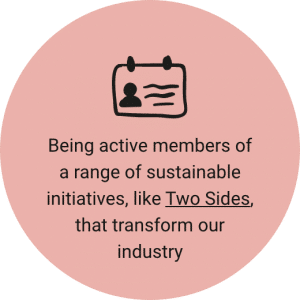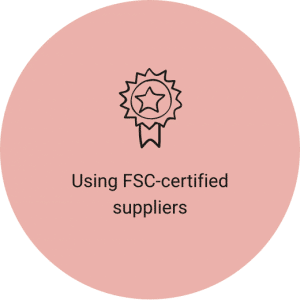It’s no secret that the earth is getting warmer!
The planet’s atmosphere has risen 0.9 Degrees Celsius since the late 19th century. This is mainly due to carbon dioxide and other man-made emissions in the atmosphere (source Nasa). Industries have to make changes, and the print industry has made some considerable changes in the past few years. Here’s how the print industry is changing to help the environment, what you can do regarding your offline marketing materials and busting some of the myths regarding print and the climate.
Facts and just the facts
There have been lots of myths surrounding the print industry and the environment. A study commissioned by Two Sides went about combating these myths. So here are some of the myths and the facts debunking these.
Forests are shrinking
59% of people asked, believe that European forests are shrinking. There is some truth behind this claim. Globally, the forests are shrinking due to climate change, deforestation and urbanisation. However, Europe has turned this on its head. European forests are actually growing. They are growing but a phenomenal amount too! European forests have actually been growing by 1500 football pitches every single day.
We don’t recycle
Recycling is a responsibility that everyone has, but many of those asked in the study believed that the European recycle rate does not exceed 60%. Again, this is incorrect the European recycling rate is 72% which is very close to the practical maximum recycling rate of 78%. 33% of people surveyed also believed that paper is a wasteful product. But this is not true either. Recycling is playing a huge part of sustainability in print. In the UK we recycle around 80% of all paper.
Paper production causes greenhouse gases
The study also showed that 25% of people asked thought that paper production is a significant cause of global greenhouse gases emissions. This myth probably makes sense BUT did you know that the pulp and paper industry is the biggest single industrial user of renewable energy in the EU (CEPI sustainability report 2018) PLUS the industries CO2 emissions have reduced by 25% between 2005 and 2017 (CEPI statistics, 2018)
What can I do?
Print is not going away in fact more people prefer reading from paper than a screen and direct mail and insert popularity is on the rise. What can you do? Using sustainable paper is an excellent way of reducing your impact. Just look for the FSC logo. Another statistic from the study showed that only £4% of people in Europe are aware of the FSC and what they do. So we will answer those questions now.
What is the FSC and what do they do?
The FSC work to protect the world’s forests. Their slogan is “Forests For All Forever”. They support this through an internationally recognised certification system. They audit every company along the supply chain that deals with timber from an FSC certified forest. As previously stated, the consumption of paper continues to grow and the FSC work to ensure that the paper and print industry secure a long term source of paper. So when ordering paper for your printers or any offline marketing materials ensure to check for the FSC logo.
When designing your work, make sure you include the FSC logo. Or go one further and include the chain of custody code. This nifty code allows you to trace the paper all the way back from the paper to the forest where the tree was fell. Don’t forget to put a message on your offline marketing piece that states what the FSC logo stands for. All of PSE’s paper stock is sourced from sustainable forests from Europe.
Go carbon neutral
You have got a big direct mail campaign and you want to be as environmentally friendly as possible. This used to be a problem, but now there are many systems in place that ensure you can be as carbon neutral as possible. Along with the FSC logo you can purchase carbon-neutral paper with the Woodland Trust logo. The Woodland Trust aims to improve the landscape of Britain and plant more trees. The Woodland Carbon scheme ensures that companies can net off verified carbon sequestration as it takes place (usually at five-year intervals). As of writing the programme has over 56,000 tonnes of carbon has been captured under this scheme.
Environmentally friendly paper
As well as recycled paper, there is an abundance of eco-friendly paper which can be made from lots of different materials. This paper is made plant-based fibres and is fully compostable so to paraphrase a particular Disney movie “the paper completes the circle of life”. Up to 50% of this paper is made from resource-saving fibres such as cotton, wheat straw, chlorophyll (grass) and cannabis (no you can’t smoke it). All of these different types of paper give a different aesthetic and if used in the right way can really make a piece of print pop and send a valuable message to your customers that you are doing what you can to help the environment.
Conclusion
The print industry is always changing and looking for better ways to improve their carbon footprint. PSE is always looking for new and innovative ways to market your business whilst being friendlier to the environment. Hopefully, this blog has given you some ideas you can implement into your future campaigns and busted some of the myths surrounding print. If you would like to discuss any future campaigns and how to make them more environmentally friendly, please get in touch with our friendly team and let’s make the world a more sustainable place.










